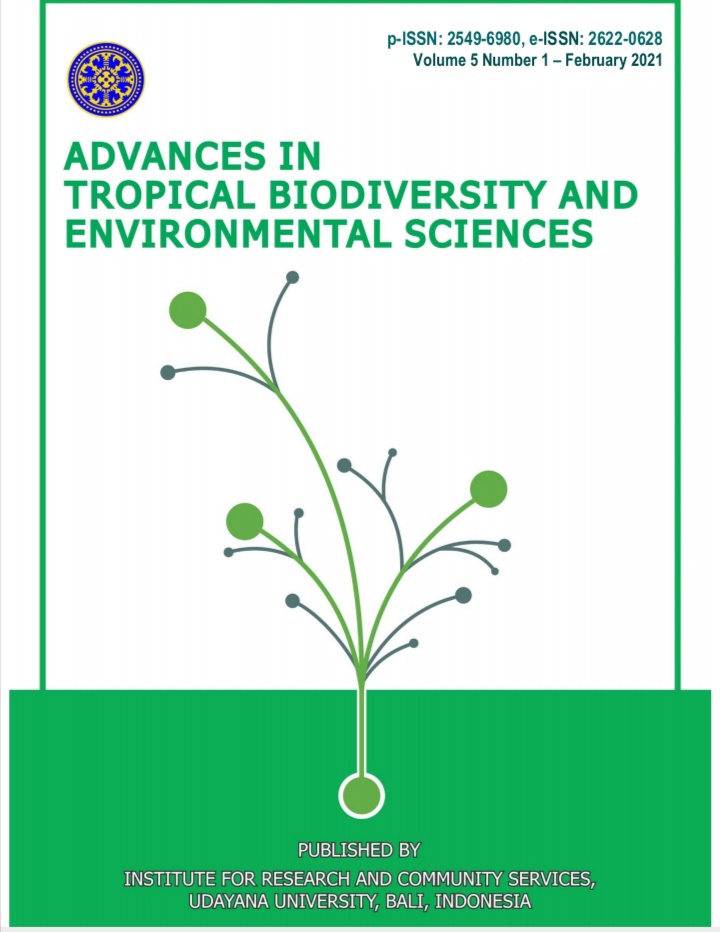Protection of Thiophenone in Catfish (Clarias sp.) Larvae When Challenged with Aeromonas hydrophila
Abstract
This research aimed to determine the ability of quorum sensing inhibitor compound thiophenone to protect catfish (Clarias sp.) larvae when challenged with the pathogenic Aeromonas hydrophila. This research was conducted at Fisheries Laboratory, Faculty of Marine Science and Fisheries, Udayana University, from December 2019 to January 2020. The experiment was setting up with four treatments and three replications for each treatment. 10 larvae of catfish were maintained in aquarium 15 cm × 15 cm × 20 cm filled with 1 liter of freshwater and used aeration for oxygen supply. The treatments were treatment A (control), treatment B (addition of A. hydrophila 106 cfu/ml), treatment C (addition of thiophenone 10 µM), and treatment D (addition of A. hydrophila 106 cfu/ml and thiophenone 10 µM). The results showed that the addition of thiophenone 10 µM increased the survival of catfish larvae up to 73% when challenged with A. hydrophila. That was significantly difference (P<0,05) compare to treatment B with survival rate of 43% within 3 days of culture period. Although it was not statistically different (P>0,05), the highest absolute weight and length were found in treatment A of 0,47 g and 0,50 cm, respectively, while the lowest absolute weight and length were found in treatment B about 0,23 g and 0,17 cm, respectively. The water quality such as temperature, pH and DO were still within the range that supported the growth and survival of catfish larvae during this study.
Downloads
References
[2] Elpawati, E., Pratiwi, D. R., & Radiastuti, N. 2015. Application of effective microorganism 10(EM10) for thr growth of sangkuriang catfish (Clarias gariepinus var. Sangkuriang) in the Jombang cathfish cultivation pond, Tangerang. Al-Kauniyah: Jurnal Biologi, 8(1): 6-14.
[3] Setyaningsih, L. 2017. Control of Aeromonas hydrophila infection in catfish with probiotic microcapsules at different doses and frequencies. Tesis. Bogor, Indonesia: Institut Pertanian Bogor.
[4] Cipriano, R.C. 2001. Aeromonas hydrophila and Motil Aeromonas Septicemia of Fish. United States Departement of the Interior Fish and Wild Life Service Division of Fisheries Research: Washington DC (pp.25).
[5] Maisyaroh, L. A., Susilowati, T., Haditomo, A. H. C., Yuniarti, T., & Basuki, F. (2018). Use of mangosteen (Gracinia mangostana) rind extract as antibacterial to treat Aeromonas hydrophila infection in tilapia (Oreochromis niloticus). Sains Akuakultur Tropis, 2(2): 36-43.
[6] Patel, B., Kumari, S., Banerjee, R., Samanta, M., & Das, S. 2017. Disruption of the quorum sensing regulated pathogenic traits of the biofilm-forming fish pathogen Aeromonas hydrophila by tannic acid, a potent quorum quencher. Biofouling, 33(7): 580-590.
[7] Witso, I. L., Benneche, T., Vestby, L. K., Nesse, L. L., Lönn-Stensrud, J., & Scheie, A. A. 2014. Thiophenone and furanone in control of Escherichia coli O103: H2 virulence. Pathogens and disease, 70(3): 297-306.
[8] Pande, G. S. J., Scheie, A. A., Benneche, T., Wille, M., Sorgeloos, P., Bossier, P., & Defoirdt, T. 2013. Quorum sensing-disrupting compounds protect larvae of the giant freshwater prawn Macrobrachium rosenbergii from Vibrio harveyi infection. Aquaculture, 406(1): 121-124.
[9] Effendi, Bugri I.N.J., & Widanarni. 2006. Effect of density on the survival and growth of Osphronemus gourami gourami seed size 2cm. Jurnal Akuakultur Indonesia, 5(2): 127-135.
[10] Wahjuningrum, D., Astrini, R., & Setiawati, M. 2013. Prevention of Aeromonas hydrophila on catfish juvenile using garlic and shatterstone herb. Jurnal Akuakultur Indonesia, 12(1): 86-94.
[11] Nurfaidah, S. (2015). Imunogenisitas Aeromonas hydrophila Strain GK–01 DAN GB–01 Terhadap Lele Dumbo (Clarias gariepinus). Skripsi. Purwokerto, Indonesia: Universitas Muhammadiyah Purwokerto.
[12] Defoirdt, T. & Sorgeloos, P. 2012. Monitoring of Vibrio harveyi quorum sensing activity in real time during infection of brine shrimp larvae. The ISME journal, 6(12): 2314-2319.
[13] Hidayat, D. & Sasanti, A. D. 2013. Survival, growth and feed efficiency of snakehead fish (Channa striata) fed raw snail flour (Pomacea sp.). Jurnal Akuakultur Rawa Indonesia, 1(2): 161-172.
[14] Asniatih, M. I. & Sabilu, K. 2013. Histopathological study of African catfish (Clarias gariepinus) infected with Aeromonas hydrophila bacteria. Jurnal Mina Laut Indonesia, 3(12): 13-21.
[15] Novitasari Y, A. Pangastuti, R. Rakhmawati. 2014.Inhibition of exoprotase enzyme production in the quorum sensing system Aeromonas hydrophila by givin methanol extract of fresh rhizome and dried galangal rhizome (Alpinia galangal). Jurnal Biofarma, 12(2): 51-61
[16] Rahayu, W. 2020. Analysis of revenue of red tilapia (Oreochromis sp.) rearing in wet water ponds in polanharjo district, klaten regency. Jurnal Ilmu-Ilmu Pertanian, 7(1): 14.
[17] Siegers, W. H., Prayitno, Y., & Sari, A. 2019. Effect of water quality on growth of Nirwana Tilapia (Oreochromis sp.) in brackish ponds. The Journal of Fisheries Development, 3(2): 95-104.
[18] Benneche T, Chamgordani E.J, Scheie A.A. 2013. Reaction of (Z)-5-(Bromomethylene) thiophen-2 (5 H)-one with Some Nucleophiles in Search for New Biofilm Inhibitors. Synthetic communications, 43(3): 431-437.
[19] Dahril, I., Tang, U. M., & Putra, I. 2017. Effect of different salinity on growth and livelihoods of red tilapia (Oreochromis sp.) seeds. Berkala Perikanan Terubuk, 45(3): 67-75.
[20] Listyani. 2017.The effect of giving tempe dregs on feed on the growth of sangkuriang catfish (Clarias gariepinus). [Skripsi]. Lampung: Universitas Islam Negeri Raden Intan.
[21] Sinaga, E. L. R., Muhtadi, A., & Bakti, D. 2016. Vertical profile of temperature, dissolved oxygen, and pH for 24 hours in kelapa gading lake, asahan regency, north sumatera. Omni-Akuatika, 12(2).













